The continued institutionalization of the new Jim Crow
With the Supreme Court denying to review the decision that found the North Carolina legislature had discriminatory intent in passing its election law, what does this mean for the future of North Carolina’s elections?
The Supreme Court of the United States, supplemented by a two–page statement written by Chief Justice John Roberts, denied certiorari on a longstanding North Carolina case involving election laws that restricted access to voting. The Court’s refusal to review the decision of North Carolina v. North Carolina State Conference of the NAACP maintains the United States Court of Appeals for the Fourth Circuit’s judgment that the restrictions imposed with the new election laws were racially motivated and had not only a discriminatory impact but were based on discriminatory intent as well.
Before enacting this session law, the North Carolina legislature requested and received racial data as to usage of the practices changed by the proposed law.
The facts of the dispute centered around provisions within North Carolina’s Session Law (SL) 2013–381. This particular election law imposed five restrictions that were challenged by various plaintiffs in the action.
The first provision was a stricter voter identification (ID) requirement. Prior to SL 2013–381, all government–issued IDs, even those that had expired, would satisfy North Carolina’s ID requirement for voting if a potential voter did not have a Department of Motor Vehicles issued photo ID. Before enacting this session law, the North Carolina legislature requested and received racial data as to usage of the practices changed by the proposed law. The data revealed that black people disproportionately lacked the most common kind of ID, a DMV–issued ID. The law would effectively exclude many of the IDs that black voters had, while keeping only those types of identification that white voters had.
The second provision of the bill eliminated the first week of early voting. The record from the district court indicates that prior to amending the provision to have this effect, the legislature requested data as to the racial breakdown of early voting usage. This data showed that “60.36% and 64.01% of [black voters] voted early in 2008 and 2012, respectively, compared to 44.47% and 49.39% of white [voters].” Specifically, black voters used the first seven days of early voting far more prevalently than white voters. The elimination of this first week included the elimination of one of two Sundays—a day in which black voters exercised their constitutional right far more frequently than white voters.
Provision three centered around same–day registrants. The district court deciding the election law found that “it [was] indisputable that [black] voters disproportionately used [same–day registration] when it was available. SL 2013–381 eliminated same–day registration, effectively also eliminating a notable amount of potential black voters who constituted a “disproportionate percentage of the incomplete registration queue” and would likely need to re–register on election day. Just like the first two challenged provisions, provision three was not amended until after the legislature requested data on the racial makeup of same–day registrants.
If a voter in North Carolina appeared at the wrong voting precinct, but was in the correct county, that voter’s ballot items would still be eligible under provisional voting. The General Assembly (GA) that enacted out–of–precinct voting found that black voters had a high percentage of provisional ballots outside their resident precinct. The fourth challenged provision of SL 2013-381 completely eliminated out–of–precinct voting.
The last provision challenged was the elimination of preregistration. Preregistration allowed 16 and 17–year–olds to state their intent to vote when obtaining their driver’s licenses or attending a registration drive at their particular school. The effect of this is that when these students turned 18, they would be automatically registered to vote by the County Boards of Elections.
The plaintiffs alleged that these five provisions were enacted with racially discriminatory intent in violation of the Equal Protection Clause and Section 2 of the Voting Rights Act. The Equal Protection Clause prohibits states from denying any person equal protection under the law. Section 2 of the Voting Rights Act restricts states or political subdivisions from imposing a voting qualification or prerequisites to vote that result in a denial or abridgement of the right of any citizen to vote due to their race or color. Here, it is necessary to note the 2013 Supreme Court case Shelby County v. Holder because it is a decision that eliminated “preclearance.” Under Section 5 of the Voting Rights Act, certain jurisdictions nationwide, including 40 North Carolina jurisdictions, were required to demonstrate that a change in voting procedures or qualifications neither had the purpose nor effect of lessening citizens’ ability to vote because of their race or color. The day after the Supreme Court issued its opinion, the Republican Chairman of the Senate Rules Committee, Tom Apodaca, announced that an omnibus bill would be coming out, which eventually became SL 2013–381.
With SL 2013–381 being a facially neutral law, the Court had to look at the circumstantial and direct evidence of the legislature’s intent to determine whether or not the law’s enactment was racially motivated.
After finding in district court that SL 2013-381 was not enacted with discriminatory intent, the plaintiffs appealed to the Court of Appeals for the Fourth Circuit, who tackled the challenged provisions. It found the district court’s findings clearly wrong and ultimately reversed the lower court’s decision. With SL 2013–381 being a facially neutral law, the court had to look at the circumstantial and direct evidence of the legislature’s intent to determine whether or not the law’s enactment was racially motivated. The court referred to a past Supreme Court decision called Village of Arlington Heights v. Metropolitan Housing Development Corp. This decision provided a non–exhaustive list of factors to consider which included “the historical background of the challenged decision; the specific sequence of events leading up to the challenged decision; departures from normal procedural sequence; the legislative history of the decision; and of course, the disproportionate impact of the official action—whether it bears more heavily on one race than another.”
With those and other considerations in mind, the court analyzed the factual dispute it faced. The Court first looked to the historical background of the challenged decision and found that the record was replete with “instances since the 1980s in which the North Carolina legislature has attempted to suppress and dilute the voting rights of [black voters].” The Court then outlined these instances extensively, which included objections from the Department of Justice, a pattern of laws producing discriminatory results, and private claims that were brought successfully under Section 2 of the Voting Rights Act. Ultimately, the district court failed to analyze whether or not the law was motivated by discriminatory intent. The Court of Appeals reversed the factual findings by stating, “the record makes clear that . . . the GA enacted [the challenged provisions] in the immediate aftermath of unprecedented [black] voter participation in a state with a trouble racial history and racially polarized voting.”
The specific sequence of events leading up to the challenged decision not only informed the Court of Appeals opinion, but “devastat[ed]” it. The initial draft of SL 2013–381 was sixteen pages in length, contained none of the above challenged provisions except a less restrictive ID requirement, was debated in public hearing and in the House for about six weeks, and there was some bipartisan support. Once the Supreme Court handed down Shelby County, the new version of the bill was fifty–seven pages in length, contained all of the challenged provisions including the now stricter ID requirement, received no minority partisan support, and was passed through the GA and signed into law in three days. The Court goes on to condemn the GA’s “rush through the legislative process the most restrictive voting law North Carolina has seen since the era of Jim Crow” and adds another factor to the “compelling piece of the puzzle of the GA’s motivation.”
The Court held that the plaintiffs had established that race was a motivating factor in the enactment of SL 2013–381 and the burden had shifted upon the law’s defenders to demonstrate that this factor had no bearing on the passage of the law.
The Court of Appeals then reasoned that because the GA requested racial data in such a manner and proceeded to enact legislation restricting practices disproportionately used by black voters, it could not ignore the choices the GA had made with that data. Ruling that the district court had erred in its findings that the challenged provisions did not bear more heavily on black voters, the court reasoned that “cumulatively, the panoply of restrictions results in grater disenfranchisement than any of the law’s provisions individually.” At the end of its Arlington Heights factor analysis, the court held the plaintiffs had established that race was a motivating factor in the enactment of SL 2013–381 and the burden had shifted upon the law’s defenders to demonstrate that this factor had no bearing on the passage of the law. The reasons for the enactment of each provision were rejected by the court and led to the conclusion that “race constituted a but–for cause of SL 2013–381, in violation of the Constitutional and statutory prohibitions on intentional discrimination.”
These challenged provisions were struck down by the Court of Appeals as unconstitutional; however, North Carolina election law will continue to be debated and bills will continue to be passed. SL 2013–381 still has other provisions that remain law until challenged by potentially disenfranchised citizens. The Court of Appeals for the Fourth Circuit methodically recognized that “voting is of the most fundamental significance under our constitutional structure” and when legislation is passed that disenfranchises this Constitutional right, it is up to citizens and defenders of these precious rights to challenge their legislature and ensure that their motivations for enacting such election laws do not carry extreme prejudicial biases.






